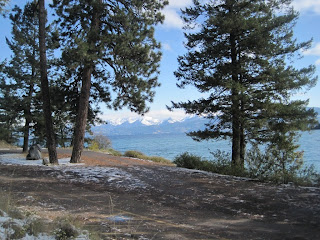The beauty of trees

Ponderosa Pines in the Rocky Mountains
Photo credit: Margaret Wilson
"What's the most beautiful thing in the world?" my uncle asked me.
As we waited for lunch in a hotel dining-room overlooking a London park ablaze with autumn colour, I wondered as a raw and immature 15-year-old what kind of reply he was expecting. "A naked woman?" I thought, tentatively, but of course didn't dare to suggest.
"A tree," he stated, as if it was the most obvious thing in the world.
I don't suppose that I displayed any reaction to his stunningly simple answer. But I've always remembered the scene, and I have to admit that trees have grown on me over the half century that has elapsed since that moment.
Michael Wilson has been, as he told us, "inspired by the beauty of trees" since the time he spent working at the University of Washington in Seattle 40 years ago. However it was also their grandeur, and the vastness of the forests that he and his wife Margaret trekked through, which were dominant themes in his talk on Monday 15 November to the Friends of Fairlynch Museum, in Budleigh Salterton.
'Trees of North America' began with a helpful slide showing us where Seattle was situated. In the background, 80 miles away, was the 14,410 ft Mount Rainier and below it the real subject of interest: the Cascade Mountains with their forests, stretching an immense distance from Canada in the north all the way down to California.
Dr Wilson explained that the great size of trees, such as the, the Sitka Spruce, Grand Fir and the Douglas Fir which often reaches up to 220 ft in height, is due to the average annual rainfall of 12 ft caused by rain laden winds from the Pacific. Among other extraordinary statistics mentioned in connection with this part of America was the age of the Giant Sequoias some of which have been reckoned to be 3,500 years old.
Then it was over to Newfoundland on the Eastern seaboard and down to Maine, where Dr Wilson explained how thousands of White Pine trees were felled over the centuries for the King's Navy.
We learnt of other varied uses to which the different timbers have been put, with Western Red Cedar being used for totem poles, dugout canoes, fencing and roof shingles. Spruce has been used in the manufacture of both violins and World War Two aircraft because of its strength and lightness, and the cellulose from Western Hemlock was used to make rayon. And there were plenty of other interesting details in the talk, such as the origin of Leylandii, the bane of many UK gardens.
Trees, he explained, were easier for him and Margaret to study rather than birds because "they don't move." On the other hand, they're less easy to photograph, being so tall. That didn't prevent him from showing some fascinating pictures, taken mostly by Margaret, including one of a sea of driftwood on the West coast, the immense trunk of a fallen Western Red Cedar, young brown bears in the wild learning how to catch salmon, logging using rivers, and the beautiful Fall colours of foliage from trees like the Scarlet Oak and the Sugar Maple on the eastern seaboard.
Dr Wilson was clearly fascinated by the lives of some of the 19th century botanists and adventurers who introduced these American trees to Europe. It was the Scottish naturalist Archibald Menzies (1754-1842) who first identified the Douglas Fir when he was ship’s surgeon and naturalist with Captain G. Vancouver during his round-the-world voyage. It was David Douglas (1798-1834) who came to the Pacific Northwest to ‘botanize’ for the Horticultural Society and who sent back specimens of this tree which were grown from seed to maturity in Scotland. He was an extraordinary character who was willing to accept extreme hardships such as he endured while exploring the forests of Oregon in search of the Sugar Pine. He came to a tragic early end, at the age of 36, when he fell into a bull pit while scrambling up a mountain in Hawaii.
The trees were the real stars of Dr Wilson's talk however. It was not difficult to understand the attraction that he feels, 40 years on, for that other world of vast green spaces, and for what he called "the joy of the American forest" standing in such stark contrast to the "horrid" aspects of an increasingly urbanised society.



Comments
Post a Comment